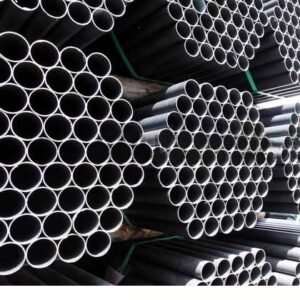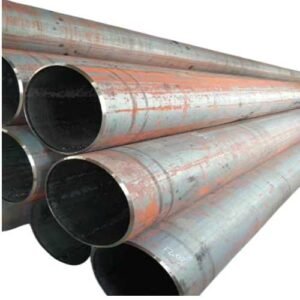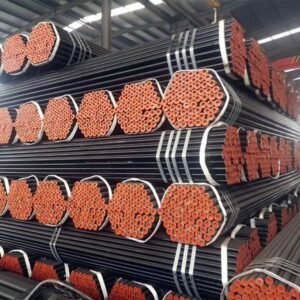Hot rolled seamless steel pipe is processed at high temperatures, resulting in a rougher surface and looser tolerances but lower cost.
Cold drawn seamless steel pipe undergoes further processing at room temperature, delivering tighter tolerances, higher strength, and a smooth finish, though at a higher price point.

Let’s break down the manufacturing processes and specific properties so you can make the right choice for your next order.
Hot Rolled vs Cold Drawn Seamless Pipe?
Many buyers assume that “seamless” simply means one type of pipe. However, the method of manufacturing changes the steel’s internal structure significantly.
The main difference lies in the processing temperature. Hot rolled pipe is formed while the steel is red-hot and malleable. Cold drawn pipe takes that hot rolled pipe and processes it again at room temperature to refine its size and properties.
Understanding the Fundamental Split
To really understand this, we need to look at how steel reacts to heat. When I walk through our factory in Hebei, I see the difference immediately. Hot rolled pipes come off the production line dark and covered in scale. Cold drawn pipes look shiny and precise.
These are not just visual differences. They represent two completely different approaches to steel manufacturing. One prioritizes speed and volume (Hot Rolled). The other prioritizes precision and quality (Cold Drawn).
The industry divides these into two categories because they serve different needs. You would not use a rough hot rolled pipe for a hydraulic piston. It would destroy the seals. You also would not use an expensive cold drawn pipe for a simple water line buried underground. It would be a waste of money.
Comparison Overview
Here is a quick look at how they compare before we go into the details.
| Feature | Hot Rolled | Cold Drawn |
|---|---|---|
| Processing Temp | >1700°F (High Heat) | Room Temperature |
| Primary Benefit | Low Cost | High Precision |
| Production Speed | Fast | Slow |
| Main Use | Structural / Transport | Machinery / Parts |
In my experience exporting to the Middle East and South America, 80% of general construction projects use hot rolled pipes. But for our clients making automotive parts, 100% require cold drawn.
What Is Hot Rolled Seamless Pipe?
Need a cost-effective solution for general structural lines or fluid transport? Many buyers overspend on precision they do not actually need for standard applications.
Hot rolled seamless pipe is manufactured by piercing a hot steel billet at temperatures above its recrystallization point, typically over 1700°F. This process creates a workable hollow tube. It is the most common choice for fluid transport and structural use where minute dimensional precision is not critical.
The Hot Rolling Process
The process starts with a solid round steel billet. We heat this billet in a furnace until it glows bright orange. At this temperature, steel becomes plastic-like. It is soft and easy to shape.
A piercing mill pushes a point through the center of the billet. This creates a hollow shell. Rollers then squeeze the shell to reduce the diameter and wall thickness to the desired size. Because the steel is hot, we can move a lot of material very quickly.
However, there is a catch. Steel expands when it is hot and shrinks when it cools. After rolling, the pipe sits on a cooling bed. As it cools down to room temperature, it shrinks. This shrinking is not perfectly uniform. This leads to slight variations in the final size.
Characteristics of Hot Rolled Pipe
Since we started our factory in 1983, hot rolled pipes have been our volume product. They are robust and reliable. The grain structure of the steel is “normalized.” This means the steel is essentially relaxed. It has no internal stress.
The surface is the most obvious identifier. It is usually dark gray or black. It feels rough to the touch. This is because of “mill scale.” Mill scale is a layer of iron oxide that forms when hot iron reacts with oxygen in the air.
When to Use It
Hot rolled pipe is the workhorse of the industry. It is perfect for:
- Large Structures: If you are building a warehouse or a bridge, you do not need the pipe to be accurate to 0.1mm.
- Pipelines: Oil, gas, and water lines usually use hot rolled pipes.
- Machining Stock: If you plan to machine off the outer surface anyway, start with hot rolled. It is cheaper.
| Characteristic | Description |
|---|---|
| Surface | Rough, scaled, dark oxide layer |
| Dimensions | Less precise due to cooling shrinkage |
| Grain Structure | Equiaxed (relaxed) grains |
| Cost | Economical |
What Is Cold Drawn Seamless Pipe?
Does your project require tight fits, shiny surfaces, or high strength? Relying on standard pipes for precision parts often leads to expensive machining work later.
Cold drawn seamless pipe (CDS) starts as a hot rolled tube but is processed further at room temperature. The pipe is pulled through a die to reduce its diameter and wall thickness. This cold working improves yield strength, dimensional accuracy, and surface finish significantly compared to hot rolled options.
The Cold Drawing Process
Cold drawn pipe is actually a “value-added” product. It starts its life as a hot rolled pipe (we call this the “mother pipe”).
First, we must clean the mother pipe. We submerge it in an acid bath. This process is called pickling. It removes all the scale and rust. After washing, we coat the pipe with a special lubricant.
Then comes the drawing. We pull the pipe through a die (a metal ring) and over a mandrel (a solid bar inside the pipe). This is done at room temperature. It is like stretching a piece of chewing gum, but with tons of force.
Because the steel is cold, it does not shrink after processing. The size it is drawn to is the size it stays. This allows for incredibly tight tolerances.
Why We Do It
The main reason to cold draw a pipe is precision. If a client sends me a drawing with a tolerance of ±0.10mm, I know I cannot use hot rolled pipe. I must use cold drawn.
Another reason is size range. Hot rolling mills cannot easily make very small pipes (like under 1 inch) or pipes with very thin walls. Cold drawing allows us to produce small, delicate sizes that hot mills cannot handle.
Mechanical Changes
The process does more than change the size. It changes the steel itself. When you stretch steel cold, you distort the crystal lattice. This creates “dislocations” in the atomic structure. This phenomenon is called work hardening.
The result? The pipe becomes harder and stronger. The tensile strength increases. However, it also becomes less ductile (less stretchy). Often, we have to heat the pipe again (annealing) after drawing to give it some flexibility back.
| Characteristic | Description |
|---|---|
| Surface | Smooth, shiny, scale-free |
| Dimensions | Very precise (High Tolerance) |
| Grain Structure | Elongated (stressed) grains |
| Cost | Premium |
Differences in Strength, Tolerance, Surface Quality
Worried about pipes failing under pressure or not fitting your equipment? Ignoring the specific physical properties is the biggest mistake in material selection.
Cold drawn pipes offer higher yield strength and hardness due to work hardening, along with strict dimensional tolerances. Hot rolled pipes have lower internal stress but looser tolerances and a rough, scaly surface. Surface quality is the most visible difference between the two.
1. Strength and Hardness
This is a critical point for engineers. If you buy a Grade B pipe in hot rolled versus cold drawn, they act differently.
- Cold Drawn: Because of the work hardening I mentioned earlier, cold drawn pipes typically have higher Yield Strength and Tensile Strength. They are stiffer. They resist bending better. This is great for hydraulic cylinders or automotive axles.
- Hot Rolled: These pipes are softer. The cooling process relieves internal stress. This makes them easier to cut and weld. If your project requires a lot of bending on site, hot rolled might actually be better because it is less likely to crack.
2. Dimensional Tolerance
Tolerance is just a fancy word for “how close is the actual size to the theoretical size.”
- Hot Rolled: Imagine baking a cookie. It shrinks as it cools. Hot rolled pipes work the same way. The wall thickness might vary by +/- 12.5%. The outer diameter might vary by +/- 1%.
- Cold Drawn: This is like using a cookie cutter. The die controls the size perfectly. We can achieve tolerances of +/- 0.05mm or even better. The wall thickness is very uniform. This is crucial if you are spinning the pipe at high speeds (like a drive shaft) to prevent vibration.
3. Surface Quality
For my clients in the furniture or decorative industry, this is the only thing that matters.
- Hot Rolled: The surface has a scale. It looks industrial. You must sandblast or pickle it if you want to paint it nicely.
- Cold Drawn: The surface is smooth and often shiny. It looks like bare metal. It takes paint, chrome plating, or galvanizing very well with minimal preparation.
| Feature | Hot Rolled Seamless | Cold Drawn Seamless |
|---|---|---|
| Yield Strength | Lower (Standard) | Higher (Enhanced) |
| Hardness | Softer | Harder |
| OD Tolerance | Loose (+/- 1%) | Tight (+/- 0.1%) |
| Wall Uniformity | Variable | Uniform |
| Finish | Scaly / Rough | Smooth / Polished |
Price Difference
Is your procurement budget tighter than expected? You might be paying a premium for “pretty” pipes that will just get buried underground or covered in insulation.
Cold drawn seamless pipes generally cost 20% to 50% more than hot rolled pipes. This price increase covers the extra processing steps, including acid pickling, lubricating, multiple drawing passes, and often heat treatment (annealing) to restore ductility after the cold working process.
Why Is Cold Drawn More Expensive?
As a factory owner, I can tell you exactly where the money goes. It is not just profit margin; it is production cost.
- Raw Material Logic: We have to make a hot rolled pipe first. Then we let it cool. Then we move it to a different workshop. So, you are paying for the hot rolled process plus the cold drawn process.
- Yield Loss: To pull the pipe through the die, we have to “point” the end. We crush the end of the pipe so it fits through the hole. After drawing, we cut this end off and scrap it. This wastage costs money.
- Processing Time: A hot rolling mill works fast. It spits out pipes in seconds. A cold draw bench is slow. It might take 10 minutes to process what the hot mill did in 10 seconds.
- Energy and Chemicals: We use acid for cleaning, oil for lubrication, and electricity for the draw benches and annealing furnaces.
When Is the Price Worth It?
You should pay the extra money when the “Hidden Costs” of hot rolled pipe are too high.
For example, if you buy cheap hot rolled pipe but then have to spend $50 per pipe on machining to get it to the right size, you have lost money. Buying the expensive cold drawn pipe that is already the right size would have been cheaper in total.
However, if you are just welding the pipe into a frame for a building, paying 50% more for cold drawn is a waste of budget.
Application Scenarios
Unsure if your application requires the expensive option? Using the wrong grade can lead to safety risks or wasted money on over-specification.
Hot rolled pipes are standard for structural columns, low-pressure fluid transport, and buried pipelines where finish doesn’t matter. Cold drawn pipes are essential for high-precision applications like hydraulic cylinders, automotive parts, heat exchanger tubes, and machinery components requiring tight tolerances and high strength.
Typical Uses for Hot Rolled Pipe
In my business, we ship hot rolled pipes mostly to construction companies and oil fields.
- Oil and Gas Transmission: Long pipelines (API 5L) are almost always hot rolled. The scale does not matter, and the wall thickness is sufficient for the pressure.
- Structural Piling: Pipes driven into the ground to support buildings.
- Rollers: Conveyor belt rollers often use hot rolled pipe, provided the surface roughness is acceptable.
- General Fabrication: Handrails, fencing (where aesthetics aren’t critical), and basic supports.
Typical Uses for Cold Drawn Pipe
Cold drawn pipe orders usually come from manufacturers of other products.
- Hydraulic Systems: The inside of a hydraulic cylinder must be perfectly smooth. Any roughness will destroy the rubber seals. We often supply “honed” cold drawn tubes for this.
- Heat Exchangers: These involve hundreds of tubes fitting into a metal sheet. The holes in the sheet are precise. The tubes must be precise too, or they won’t fit.
- Automotive Components: Steering columns, shock absorbers, and drive shafts. These parts spin or move. They need uniform wall thickness to stay balanced.
- Instrumentation: Small diameter tubing used for pressure gauges and sensors.
How to Choose
Still struggling to decide which pipe fits your order? A simple checklist can prevent ordering errors and expensive returns.
To choose correctly, evaluate three main factors: the required dimensional tolerance, the necessity of a smooth surface finish, and the project budget. If high precision and strength are non-negotiable, choose Cold Drawn. For general use and cost savings, Hot Rolled is the best option.
Step-by-Step Selection Guide
When a new client contacts me at JS FITTINGS, I ask them a few questions to guide them. You can ask yourself the same things.
1. Do you need to machine it? If you plan to use the pipe in a CNC machine, consider how much material you want to remove. Cold drawn pipes are closer to the final size. You remove less metal. This saves tool wear and time. If you are machining a lot anyway, hot rolled is fine.
2. Is the surface visible? If the pipe is part of a furniture piece or a visible machine part, go with cold drawn. It looks professional. If it is covered in insulation or buried, hot rolled is better.
3. What is the pressure/stress rating? Check your engineering specs. Sometimes, the work hardening of cold drawn pipe is required to handle higher pressures with a thinner wall. This can actually save weight.
4. Size Availability If you need a huge pipe (like 24 inches), you probably have to stick with hot rolled. Cold drawing equipment for massive pipes is very rare and expensive. If you need a tiny pipe (like 0.5 inches), you must use cold drawn.
Decision Matrix
Use this table to make a quick decision:
| Your Requirement | Recommended Pipe |
|---|---|
| “I need the cheapest option.” | Hot Rolled |
| “It needs to fit inside another part perfectly.” | Cold Drawn |
| “I need a shiny surface for painting/plating.” | Cold Drawn |
| “It is for a standard water/oil pipeline.” | Hot Rolled |
| “I need high tensile strength for a lightweight part.” | Cold Drawn |
| “I need a very thick wall (heavy wall).” | Hot Rolled |
Conclusion
Hot rolled pipes save you money on general applications, while cold drawn pipes provide the precision needed for advanced machinery.
If you are still unsure which pipe fits your project, contact me directly. I can help you analyze your specs and find the best solution.
Email: info@jssteelpipes.com
WhatsApp: +8618003119682





